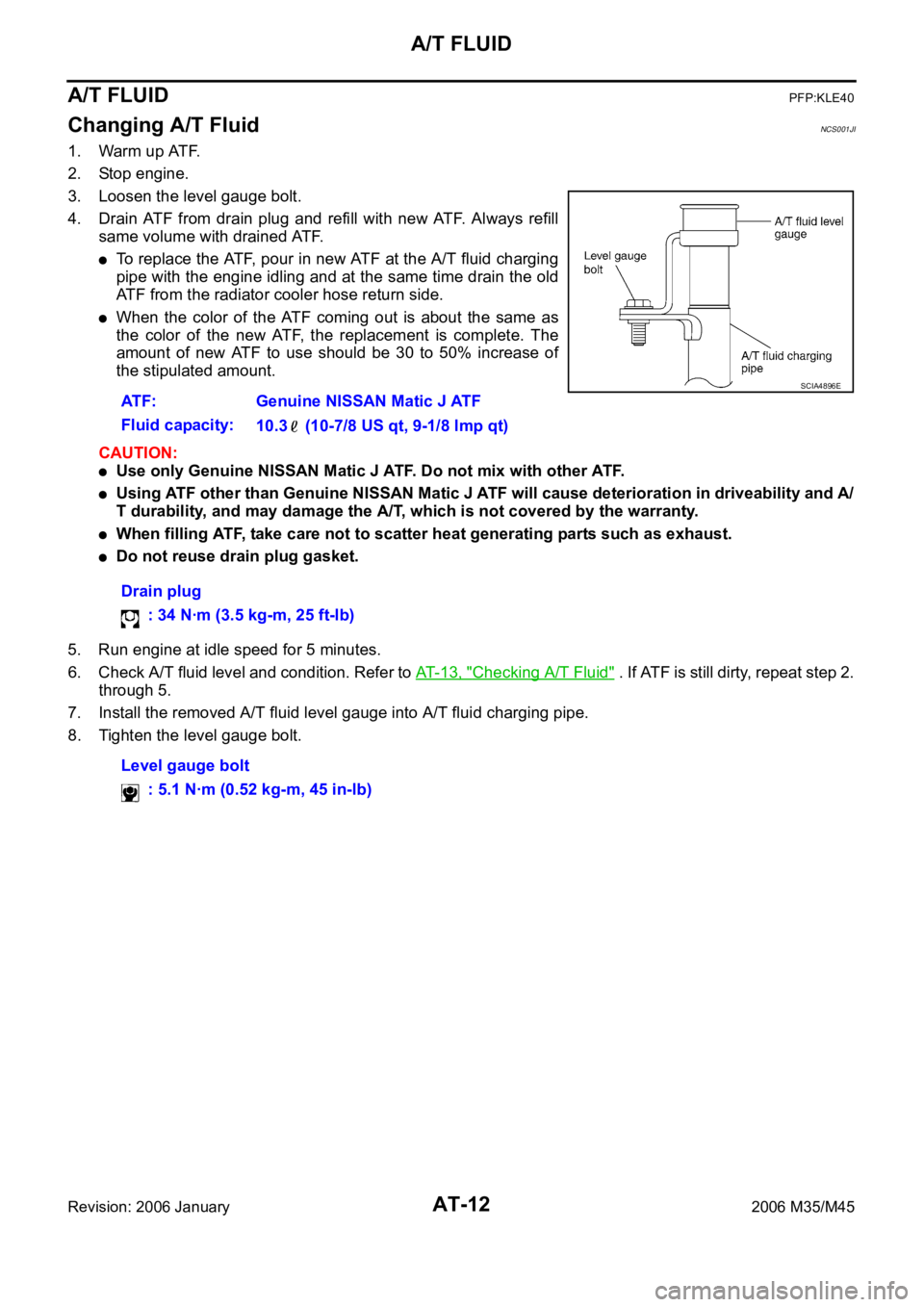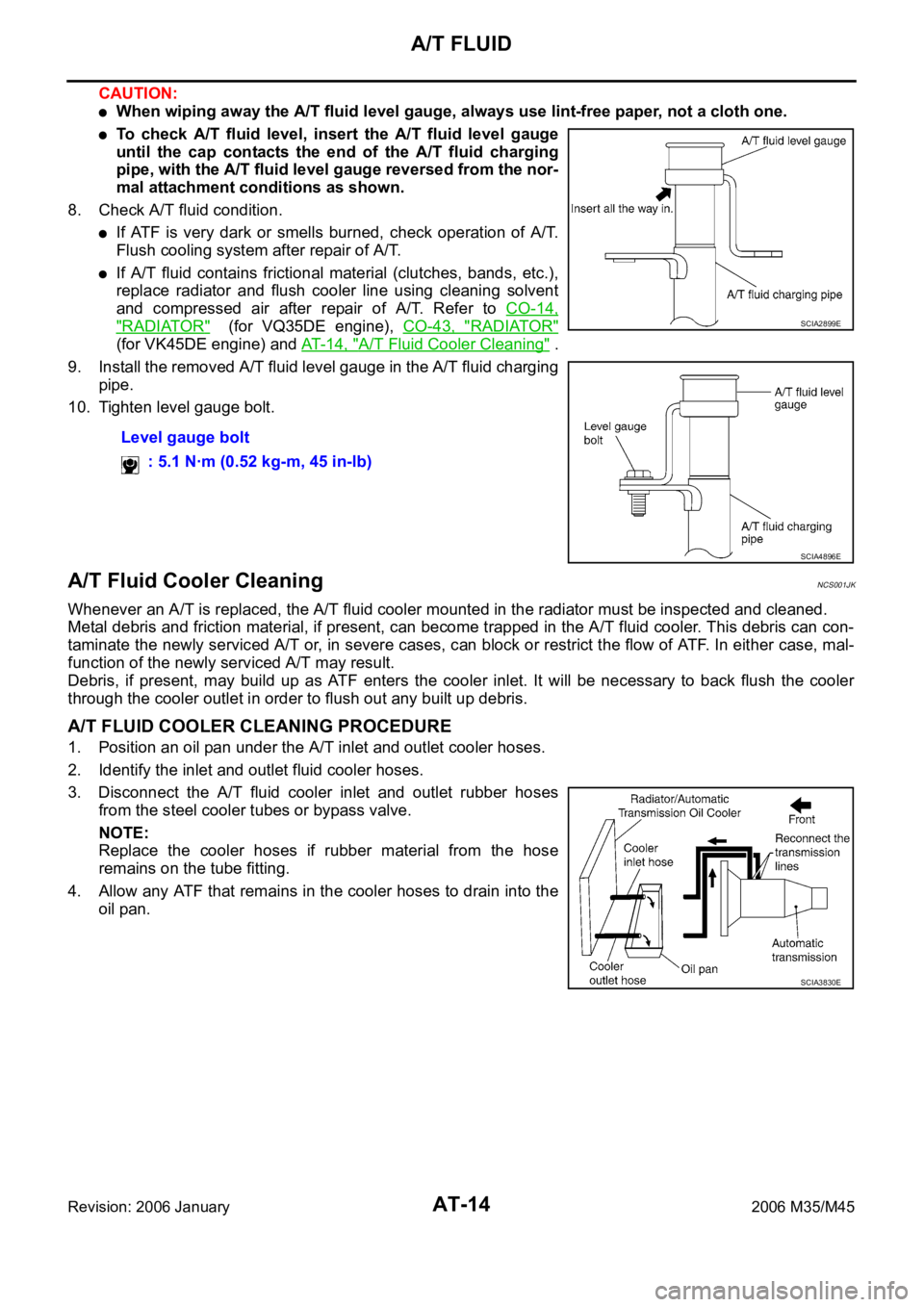stall INFINITI M35 2006 Factory Owner's Manual
[x] Cancel search | Manufacturer: INFINITI, Model Year: 2006, Model line: M35, Model: INFINITI M35 2006Pages: 5621, PDF Size: 65.56 MB
Page 90 of 5621

PREPARATION
AT-11
D
E
F
G
H
I
J
K
L
MA
B
AT
Revision: 2006 January2006 M35/M45
Commercial Service ToolsNCS001JH
To o l n a m eDescription
Power toolLoosening bolts and nuts
Drift
a: 22 mm (0.87 in) dia.Installing manual shaft oil seals
Drift
a: 64 mm (2.52 in) dia.Installing rear oil seal (AWD models)
PBIC0190E
NT083
SCIA5338E
Page 91 of 5621

AT-12
A/T FLUID
Revision: 2006 January2006 M35/M45
A/T FLUIDPFP:KLE40
Changing A/T FluidNCS001JI
1. Warm up ATF.
2. Stop engine.
3. Loosen the level gauge bolt.
4. Drain ATF from drain plug and refill with new ATF. Always refill
same volume with drained ATF.
To replace the ATF, pour in new ATF at the A/T fluid charging
pipe with the engine idling and at the same time drain the old
ATF from the radiator cooler hose return side.
When the color of the ATF coming out is about the same as
the color of the new ATF, the replacement is complete. The
amount of new ATF to use should be 30 to 50% increase of
the stipulated amount.
CAUTION:
Use only Genuine NISSAN Matic J ATF. Do not mix with other ATF.
Using ATF other than Genuine NISSAN Matic J ATF will cause deterioration in driveability and A/
T durability, and may damage the A/T, which is not covered by the warranty.
When filling ATF, take care not to scatter heat generating parts such as exhaust.
Do not reuse drain plug gasket.
5. Run engine at idle speed for 5 minutes.
6. Check A/T fluid level and condition. Refer to AT- 1 3 , "
Checking A/T Fluid" . If ATF is still dirty, repeat step 2.
through 5.
7. Install the removed A/T fluid level gauge into A/T fluid charging pipe.
8. Tighten the level gauge bolt.ATF: Genuine NISSAN Matic J ATF
Fluid capacity:
10.3 (10-7/8 US qt, 9-1/8 lmp qt)
Drain plug
: 34 Nꞏm (3.5 kg-m, 25 ft-lb)
Level gauge bolt
: 5.1 Nꞏm (0.52 kg-m, 45 in-lb)
SCIA4896E
Page 93 of 5621

AT-14
A/T FLUID
Revision: 2006 January2006 M35/M45
CAUTION:
When wiping away the A/T fluid level gauge, always use lint-free paper, not a cloth one.
To check A/T fluid level, insert the A/T fluid level gauge
until the cap contacts the end of the A/T fluid charging
pipe, with the A/T fluid level gauge reversed from the nor-
mal attachment conditions as shown.
8. Check A/T fluid condition.
If ATF is very dark or smells burned, check operation of A/T.
Flush cooling system after repair of A/T.
If A/T fluid contains frictional material (clutches, bands, etc.),
replace radiator and flush cooler line using cleaning solvent
and compressed air after repair of A/T. Refer to CO-14,
"RADIATOR" (for VQ35DE engine), CO-43, "RADIATOR"
(for VK45DE engine) and AT- 1 4 , "A/T Fluid Cooler Cleaning" .
9. Install the removed A/T fluid level gauge in the A/T fluid charging
pipe.
10. Tighten level gauge bolt.
A/T Fluid Cooler CleaningNCS001JK
Whenever an A/T is replaced, the A/T fluid cooler mounted in the radiator must be inspected and cleaned.
Metal debris and friction material, if present, can become trapped in the A/T fluid cooler. This debris can con-
taminate the newly serviced A/T or, in severe cases, can block or restrict the flow of ATF. In either case, mal-
function of the newly serviced A/T may result.
Debris, if present, may build up as ATF enters the cooler inlet. It will be necessary to back flush the cooler
through the cooler outlet in order to flush out any built up debris.
A/T FLUID COOLER CLEANING PROCEDURE
1. Position an oil pan under the A/T inlet and outlet cooler hoses.
2. Identify the inlet and outlet fluid cooler hoses.
3. Disconnect the A/T fluid cooler inlet and outlet rubber hoses
from the steel cooler tubes or bypass valve.
NOTE:
Replace the cooler hoses if rubber material from the hose
remains on the tube fitting.
4. Allow any ATF that remains in the cooler hoses to drain into the
oil pan.Level gauge bolt
: 5.1 Nꞏm (0.52 kg-m, 45 in-lb)
SCIA2899E
SCIA4896E
SCIA3830E
Page 123 of 5621

AT-44
TROUBLE DIAGNOSIS
Revision: 2006 January2006 M35/M45
TROUBLE DIAGNOSISPFP:00004
DTC Inspection Priority ChartNCS001K2
If some DTCs are displayed at the same time, perform inspections one by one based on the following priority
chart.
NOTE:
If DTC “U1000” is displayed with other DTC, first perform the trouble diagnosis for “DTC U1000 CAN
COMMUNICATION LINE”. Refer to AT- 1 0 5
.
Fail-safeNCS001K3
The TCM has an electrical fail-safe mode. This mode makes it possible to operate even if there is an error in a
main electronic control input/output signal circuit.
In fail-safe mode, even if the selector lever is “D” or “M” mode, the A/T is fixed in 2nd, 4th and 5th (depending
on the breakdown position), so the customer should feel “slipping” or “poor acceleration”.
Even when the electronic circuits are normal, under special conditions (for example, when slamming on the
brake with the wheels spinning drastically and stopping the tire rotation), the A/T can go into fail-safe mode. If
this happens, switch OFF the ignition switch for 10 seconds, then switch it ON again to return to the normal
shift pattern. Therefore, the customer's vehicle has returned to normal, so handle according to the “WORK
FLOW” (Refer to AT- 4 7
).
FAIL-SAFE FUNCTION
If any malfunction occurs in a sensor or solenoid, this function controls the A/T to mark driving possible.
Vehicle Speed Sensor
Signals are input from two systems - from vehicle speed sensor A/T (revolution sensor) installed on the A/
T and from combination meter so normal driving is possible even if there is a malfunction in one of the
systems. And if vehicle speed sensor A/T (revolution sensor) has unusual cases, 5th gear and manual
mode are prohibited.
Accelerator Pedal Position Sensor
If there is a malfunction in one of the systems, the accelerator opening angle is controlled by ECM accord-
ing to a pre-determined accelerator angle to make driving possible. And if there are malfunctions in tow
systems, the engine speed is fixed by ECM to a pre-determined engine speed to make driving possible.
Throttle Position Sensor
If there is a malfunction in one of the systems, the accelerator opening angle is controlled by ECM accord-
ing to a pre-determined accelerator angle to make driving possible. And if there are malfunctions in tow
systems, the accelerator opening angle is controlled by the idle signal sent from the ECM which is based
on input indicating either idle condition or off-idle condition (pre-determined accelerator opening) in order
to make driving possible.
PNP Switch
In the unlikely event that a malfunction signal enters the TCM, the position indicator is switched OFF, the
starter relay is switched OFF (starter starting is disabled), the back-up lamp relay switched OFF (back-up
lamp is OFF) and the position is fixed to the “D” position to make driving possible.
Starter Relay
The starter relay is switched OFF. (Starter starting is disabled.)
Priority Detected items (DTC)
1 U1000 CAN communication line
2 Except above
Page 127 of 5621

AT-48
TROUBLE DIAGNOSIS
Revision: 2006 January2006 M35/M45
DIAGNOSTIC WORKSHEET
Information from Customer
KEY POINTS
WHAT..... Vehicle and A/T model
WHEN..... Date, Frequencies
WHERE..... Road conditions
HOW..... Operating conditions, Symptoms
Diagnostic Worksheet Chart
Customer name MR/MS Model and Year VIN
Trans. Model Engine Mileage
Malfunction Date Manuf. Date In Service Date
Frequency
Continuous Intermittent ( times a day)
Symptoms
Vehicle does not move. ( Any position Particular position)
No up-shift ( 1st 2nd 2nd 3rd 3rd 4th 4th 5th)
No down-shift ( 5th 4th 4th 3rd 3rd 2nd 2nd 1st)
Lock-up malfunction
Shift point too high or too low.
Shift shock or slip ( N D N R Lock-up Any drive position)
Noise or vibration
No kick down
No pattern select
Others
()
A/T CHECK indicator lamp
Continuously lit Not lit
Malfunction indicator lamp (MIL)
Continuously lit Not lit
1 Read the item on cautions concerning fail-safe and understand the customer's complaint.AT- 4 4
2
A/T fluid inspectionAT- 5 3
Leak (Repair leak location.)
State
Amount
3
Stall test and line pressure testAT- 5 3, AT-
55 Stall test
Torque converter one-way clutch
Front brake
High and low reverse clutch
Low coast brake
Forward brake
Reverse brake
Forward one-way clutch
1st one-way clutch
3rd one-way clutch
Engine
Line pressure low
Except for input clutch and direct
clutch, clutches and brakes OK
Line pressure inspection - Suspected part:
Page 132 of 5621

TROUBLE DIAGNOSIS
AT-53
D
E
F
G
H
I
J
K
L
MA
B
AT
Revision: 2006 January2006 M35/M45
Inspections before Trouble DiagnosisNCS001K7
A/T FLUID CHECK
A/T Fluid Leakage and A/T Fluid Level Check
Inspect for A/T fluid leakage and check the A/T fluid level. Refer to AT- 1 3 , "Checking A/T Fluid" .
A/T Fluid Condition Check
Inspect the A/T fluid condition.
STALL TEST
Stall Test Procedure
1. Inspect the amount of engine oil. Replenish the engine oil if necessary.
2. Drive for about 10 minutes to warm up the vehicle so that the A/
T fluid temperature is 50 to 80
C (122 to 176F). Inspect the
amount of ATF. Replenish if necessary.
3. Securely engage the parking brake so that the tires do not turn.
4. Engine start, apply foot brake, and place selector lever in “D”
position.
Fluid condition Conceivable Cause Required Operation
Varnished (viscous
varnish state)Clutch, brake
scorchedReplace the ATF and check the A/T
main unit and the vehicle for mal-
functions (wire harnesses, cooler
pipes, etc.)
Milky white or cloudy Water in the fluidReplace the ATF and check for
places where water is getting in.
Large amount of metal
powder mixed inUnusual wear of
sliding parts within
A/TReplace the ATF and check for
improper operation of the A/T.
SAT638A
SAT647B
SCIA7463E
SCIA6787E
Page 133 of 5621

AT-54
TROUBLE DIAGNOSIS
Revision: 2006 January2006 M35/M45
5. While holding down the foot brake, gradually press down the
accelerator pedal.
6. Quickly read off the stall speed, then quickly remove your foot
from the accelerator pedal.
CAUTION:
Do not hold down the accelerator pedal for more than 5 sec-
onds during this test.
7. Move the selector lever to the “N” position.
8. Cool down the ATF.
CAUTION:
Run the engine at idle for at least 1 minute.
9. Repeat steps 5 through 8 with selector lever in “R” position.
Judgement of Stall Test
O: Stall speed within standard value position
H: Stall speed higher than standard value
L: Stall speed lower than standard value
Stall test standard value positionStall speed
VQ35DE models: 2,650 - 2,950 rpm
VK45DE models: 2,260 - 2,560 rpm
SAT514G
SCIA6788E
Selector lever position
Possible location of malfunction
“D”, “M” “R”
Stall speed HO
Forward brake
Forward one-way clutch
1st one-way clutch
3rd one-way clutch
OH
Reverse brake
LL
Engine and torque converter one-way clutch
HH
Line pressure low
Does not shift-up “D” or “M” position 1 2 Slipping in 2nd, 3rd or 4th gear Direct clutch slippage
Does not shift-up “D” or “M” position 2
3 Slipping in 3rd, 4th or 5th gear High and low reverse clutch slippage
Does not shift-up “D” or “M” position 3
4 Slipping in 4th or 5th gear Input clutch slippage
Does not shift-up “D” or “M” position 4
5 Slipping in 5th gear Front brake slippage
Page 134 of 5621

TROUBLE DIAGNOSIS
AT-55
D
E
F
G
H
I
J
K
L
MA
B
AT
Revision: 2006 January2006 M35/M45
LINE PRESSURE TEST
Line Pressure Test Port
Line Pressure Test Procedure
1. Inspect the amount of engine oil and replenish if necessary.
2. Drive the car for about 10 minutes to warm it up so that the ATF reaches in range of 50 to 80
C (122 to
176
F), then inspect the amount of ATF and replenish if necessary.
NOTE:
The A/T fluid temperature rises in range of 50 to 80
C (122 to 176F) during 10 minutes of driving.
3. Remove the front propeller shaft from vehicle (with AWD models). Refer to PR-5, "
Removal and Installa-
tion" .
4. After warming up remove the oil pressure detection plug and
install the oil pressure gauge [ST2505S001(J-34301-C)].
CAUTION:
When using the oil pressure gauge, be sure to use the O-
ring attached to the oil pressure detection plug.
5. Securely engage the parking brake so that the tires do not turn.
6. Start the engine, then measure the line pressure at both idle and
the stall speed.
CAUTION:
Keep the brake pedal pressed all the way down during
measurement.
When measuring the line pressure at the stall speed,
refer to AT- 5 3 , "
STALL TEST" .
7. After the measurements are complete, install the oil pressure
detection plug and tighten to the specified torque.
SCIA2187E
SCIA5309E
SCIA7463E
: 7.3 Nꞏm (0.74 kg-m, 65 in-lb)SAT493G
Page 135 of 5621

AT-56
TROUBLE DIAGNOSIS
Revision: 2006 January2006 M35/M45
CAUTION:
Do not reuse O-ring.
Apply ATF to O-ring.
Line Pressure
Judgement of Line Pressure Test
Engine speedLine pressure [kPa (kg/cm
2 , psi)]
“R” position “D”, “M” positions
At idle speed 425 - 465 (4.3 - 4.7, 62 - 67) 379 - 428 (3.9 - 4.4, 55 - 62)
At stall speed 1,605 - 1,950 (16.4 - 19.9, 233 - 283) 1,310 - 1,500 (13.4 - 15.3, 190 - 218)
Judgement Possible cause
Idle speedLow for all positions
(“P”, “R”, “N”, “D”, “M”)Possible causes include malfunctions in the pressure supply system and low oil pump out-
put.
For example
Oil pump wear
Pressure regulator valve or plug sticking or spring fatigue
Oil strainer oil pump pressure regulator valve passage oil leak
Engine idle speed too low
Only low for a specific
positionPossible causes include an oil pressure leak in a passage or device related to the position
after the pressure is distributed by the manual valve.
HighPossible causes include a sensor malfunction or malfunction in the line pressure adjustment
function.
For example
Accelerator pedal position signal malfunction
A/T fluid temperature sensor malfunction
Line pressure solenoid malfunction (sticking in OFF state, filter clog, cut line)
Pressure regulator valve or plug sticking
Stall speedOil pressure does not
rise higher than the oil
pressure for idle.Possible causes include a sensor malfunction or malfunction in the pressure adjustment
function.
For example
Accelerator pedal position signal malfunction
TCM breakdown
Line pressure solenoid malfunction (shorting, sticking in ON state)
Pressure regulator valve or plug sticking
Pilot valve sticking or pilot filter clogged
The pressure rises, but
does not enter the stan-
dard position.Possible causes include malfunctions in the pressure supply system and malfunction in the
pressure adjustment function.
For example
Accelerator pedal position signal malfunction
Line pressure solenoid malfunction (sticking, filter clog)
Pressure regulator valve or plug sticking
Pilot valve sticking or pilot filter clogged
Only low for a specific
positionPossible causes include an oil pressure leak in a passage or device related to the position
after the pressure is distributed by the manual valve.
Page 167 of 5621

AT-88
TROUBLE DIAGNOSIS
Revision: 2006 January2006 M35/M45
68
OthersEngine does not start
in “N” or “P” position.
Refer to AT-190, "Engine Cannot Be
Started in “P” or “N”
Position" .ON vehicle1. Push-button ignition switch and starterPG-3
, SC-
10
2. Control linkage adjustmentAT- 2 2 7
3. PNP switchAT- 11 3
69Engine starts in posi-
tions other than “N” or
“P”.ON vehicle1. Push-button ignition switch and starterPG-3
, SC-
10
2. Control linkage adjustmentAT- 2 2 7
3. PNP switchAT- 11 3
70 Engine stall.ON vehicle1. A/T fluid level and stateAT- 5 3
2. Engine speed signalAT- 1 2 4
3. Turbine revolution sensorAT- 11 7
4. Torque converter clutch solenoid valveAT- 1 2 6
5. CAN communication lineAT- 1 0 5
6. Control valve with TCMAT- 2 3 6
OFF vehicle 7. Torque converterAT- 2 9 8
71Engine stalls when
selector lever shifted
“N”
“D”or “R”.ON vehicle1. A/T fluid level and stateAT- 5 3
2. Engine speed signalAT- 1 2 4
3. Turbine revolution sensorAT- 11 7
4. Torque converter clutch solenoid valveAT- 1 2 6
5. CAN communication lineAT- 1 0 5
6. Control valve with TCMAT- 2 3 6
OFF vehicle 7. Torque converterAT- 2 9 8
72Engine speed does
not return to idle.
Refer to AT-212,
"Engine Speed Does
Not Return to Idle" .ON vehicle1. A/T fluid level and stateAT- 5 3
2. ATF pressure switch 5 and direct clutch solenoid valveAT- 1 7 6,
AT- 1 5 5
3. ATF pressure switch 1 and front brake solenoid valveAT- 1 7 2
,
AT- 1 5 1
4. Accelerator pedal position sensorAT- 1 3 2
5. Vehicle speed sensorꞏA/T and vehicle speed sensorꞏMTRAT- 11 9,
AT- 1 4 0
6. CAN communication lineAT- 1 0 5
7. Control valve with TCMAT- 2 3 6
OFF vehicle8. Front brake (brake band)AT- 2 9 89. Direct clutchAT- 3 3 7
No. Item Symptom Condition Diagnostic ItemReference
page